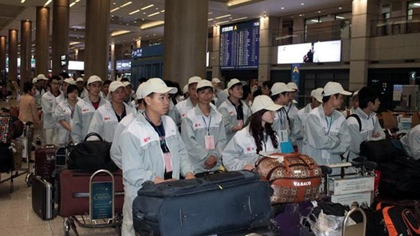Opportunities and challenges for labour export
The free movement of workers in some fields and the higher quality of labourers have shown a new trend for labour export in the context of international integration, creating both opportunities and challenges for labour export.
 |
| In the first two months of 2016, Vietnam posted 15,605 labourers working abroad. |
According to the General Statistics Office, as of January 1, 2016, the labour force of Vietnam aged 15 and over was reported at 54.61 million people with 51.7% male and 48.3% female. The rate of trained workers was 21.9%.
Vietnam also recorded more than 400,000 labours working overseas in more than 30 different occupations. 2015 saw 115,980 Vietnamese workers sent abroad, up 15% compared to the plan, and was the second consecutive year that Vietnam sent over 100,000 workers abroad.
In the first two months of 2016, Vietnam posted 15,605 labourers working abroad, equivalent to 15.61% of the year's plan and 90.69% of the same period in 2015.
The main labour export markets of Vietnam are Taiwan (China), Japan, Malaysia, the Republic of Korea, Saudi Arabia and Macau among others. In particular, Thailand allowed unskilled Vietnamese workers in four sectors to register for work permits with full rights and interests since December 2015, helping ensure the rights of Vietnamese workers.
2016 and coming years will promise growth for Vietnam's labour export thanks to labour co-operation agreements signed in 2015. Labour export will also face many new opportunities and challenges due to commitments to connect intra-regional working network signed in multilateral free trade agreements and the ASEAN mutual recognition agreements on eight professionals allowing skilled labour to move freely around ASEAN.
Many countries have increased the basic wage level and expanded the list of professions eligible for foreign workers while ensuring the equal access to administrative procedures and judicial system.
This reality will create opportunities for workers to improve their income in ASEAN member countries and in member countries of several free trade agreements, but also increase competitiveness pressure on workers amid the wave of labour movement.
In addition, enterprises have the chance to attract high qualified workers from foreign countries but are also under pressure of headhunting from manpower companies or large corporation in the region and the world.
To meet new requirements, utilise opportunities and overcome challenges in labour export, Vietnamese agencies need to promote co-ordination between training establishments and labour export companies to train workers in accordance with market demand with the focus on foreign language training, labour discipline, and the laws of guest countries.
At the same time, it is necessary to strengthen the inspection over labour export companies and impose sanctions on misconduct during the recruitment, training, tuition collection, and labour management and export.
Vietnam is in a golden population period with hundreds of thousands of university and college graduates each year, in addition to millions of labourers participating in the labour market and in need of vocational training. Meanwhile, the labour market is being internationalised and more competitive, requiring Vietnam to develop an organised labour market with higher quality workers.
(Source: NDO)
 về đầu trang
về đầu trang







